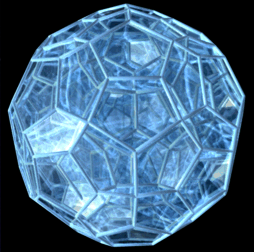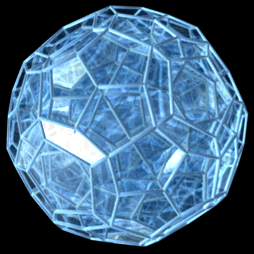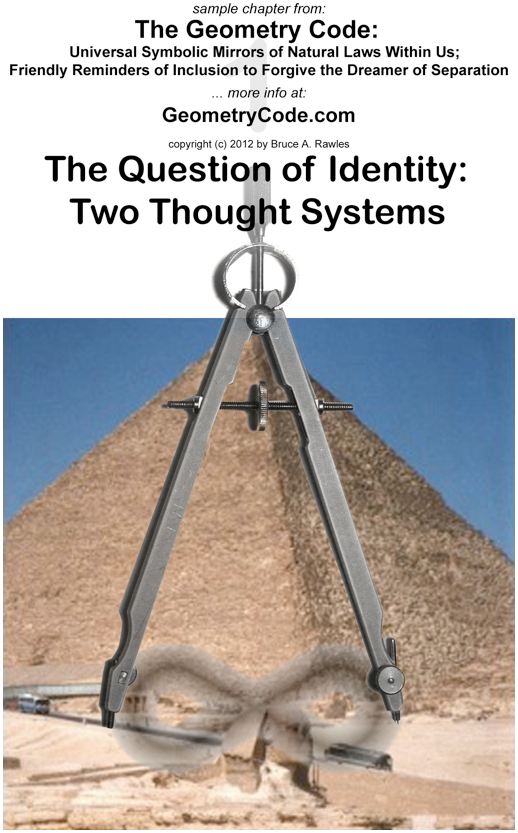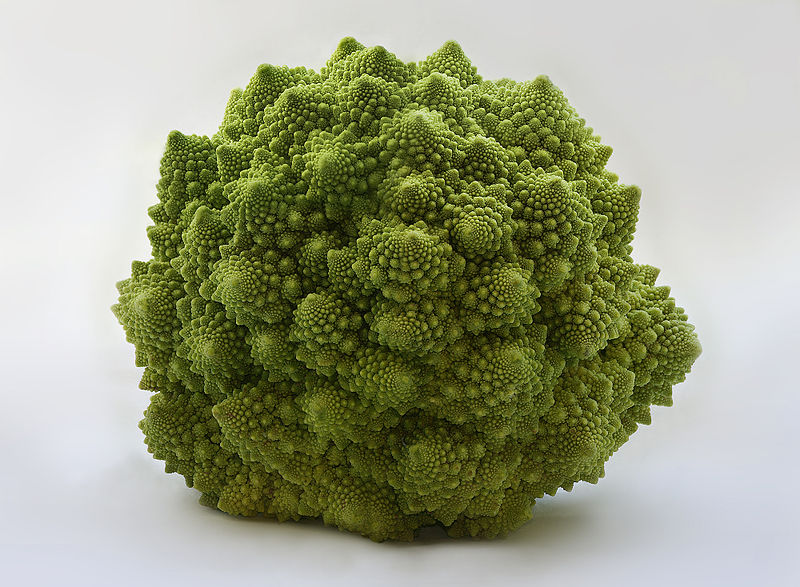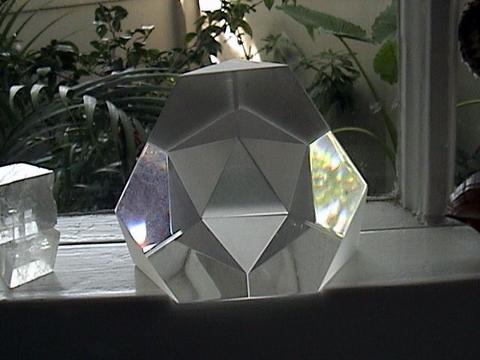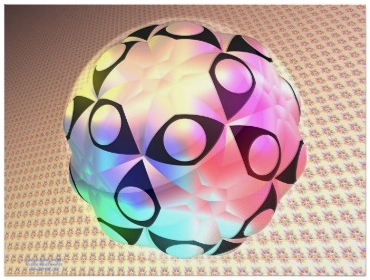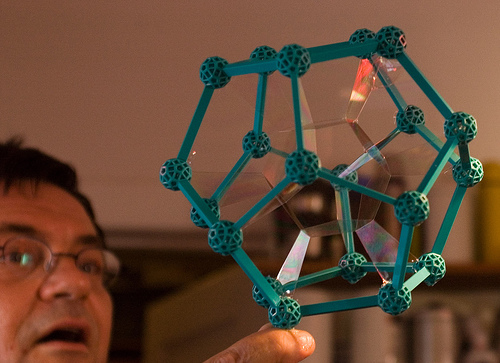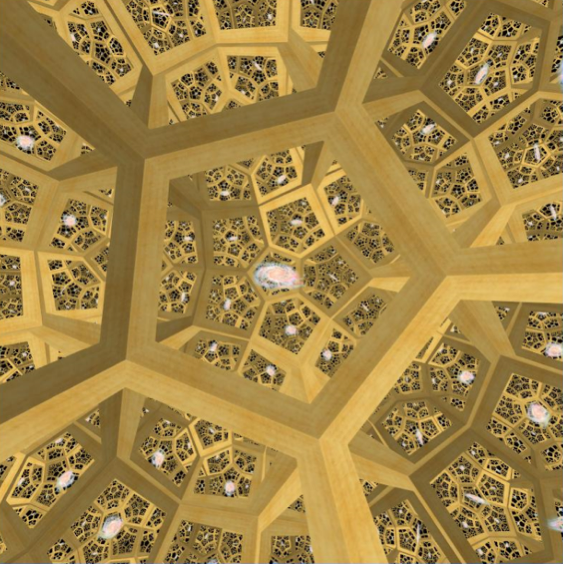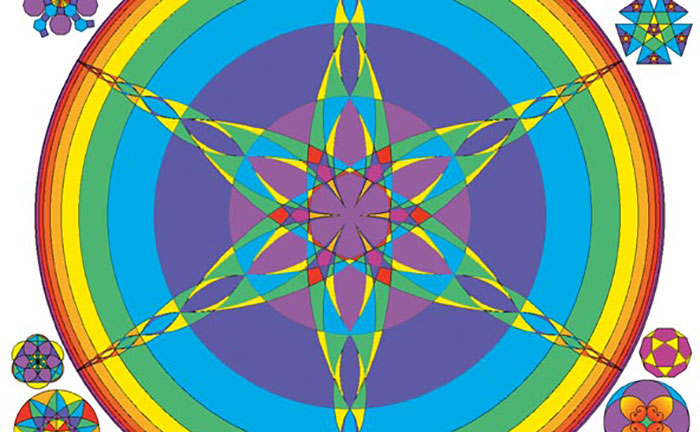 I printed and published the first copies of Sacred Geometry Design Sourcebook (SDGS) in December 1997. It took a year of intensive graphics work using Claris CAD – does anyone remember that Apple application? – to convert and extend numerous hand-drawn geometric illustrations into digital form. My wife (Nancy Bolton-Rawles) took an evening class and I started with an evening a week – while she was in class – learning how to use this early CAD program for something other than video routing switcher control panels and making these geometric archetypes with far more accuracy and resolution than I could possibly achieve by straightedge and compass (the classic geometer’s tools) or any other physical mechanical means. Those evenings quickly overflowed into seemingly every conceivable spare moment. I realized that these CAD drawings (plus a few other unique images such as a stereogram, some unusual tables, charts, spreadsheets and even a cameo illustration of a sphere by Nancy (who was taking art classes during that time) merited a book. There are over 1300 geometric CAD illustrations counting all the variations I placed in the margins of many of the larger full page (8.5″ x 11″) images.
I printed and published the first copies of Sacred Geometry Design Sourcebook (SDGS) in December 1997. It took a year of intensive graphics work using Claris CAD – does anyone remember that Apple application? – to convert and extend numerous hand-drawn geometric illustrations into digital form. My wife (Nancy Bolton-Rawles) took an evening class and I started with an evening a week – while she was in class – learning how to use this early CAD program for something other than video routing switcher control panels and making these geometric archetypes with far more accuracy and resolution than I could possibly achieve by straightedge and compass (the classic geometer’s tools) or any other physical mechanical means. Those evenings quickly overflowed into seemingly every conceivable spare moment. I realized that these CAD drawings (plus a few other unique images such as a stereogram, some unusual tables, charts, spreadsheets and even a cameo illustration of a sphere by Nancy (who was taking art classes during that time) merited a book. There are over 1300 geometric CAD illustrations counting all the variations I placed in the margins of many of the larger full page (8.5″ x 11″) images.
It’s amazing to reflect on the journey of explorations that have branched off (fractals, anyone?) from this first book by countless colleagues. I am profoundly grateful to one and all for the links, shared discoveries, and inestimable support in 2 dimensions, 3 dimensions, 4 dimensions and beyond over the past two decades … and before and after that, too – since we’re all interconnected beyond time and space! It’s been wonderful fun to get emails, postal mails of unexpected geometrically-inspired gifts, and other correspondence via Facebook (GeometryCode.com and Geometry Code) plus other social media, etc. Thanks, everyone, for your generous and steady contributions and support over the past two decades! :-)
If you are new to this website (or would like to peruse some of these topics again), you might want to start with this introduction to sacred geometry and then explore many years of bulletins, posts, and articles about related geometric coloring books – of which SGDS is a prime example! – and other sacred geometry art, books, calendars, food, audios and interviews, jewelry, music, news, physics, spaces, toys and videos, the golden ratio, Fibonacci numbers, other interesting numbers and proportions, the Platonic Solids and Archimedean Solids, other polyhedra, plus even some interconnections with the ancient, timeless Hermetic Laws and their relationship to modern physics … and metaphysics … which led to my second book, The Geometry Code: Universal Symbolic Mirrors of Natural Laws Within Us; Friendly Reminders of Inclusion to Forgive the Dreamer of Separation.
To commemorate this 20th anniversary month (December 2017) of SGDS, here is an illustration that I added later, but didn’t make it into the book: a fold-up pattern for the Rhombic Triacontahedron, also known as Kepler’s Solid, which is an example of a zonohedron.
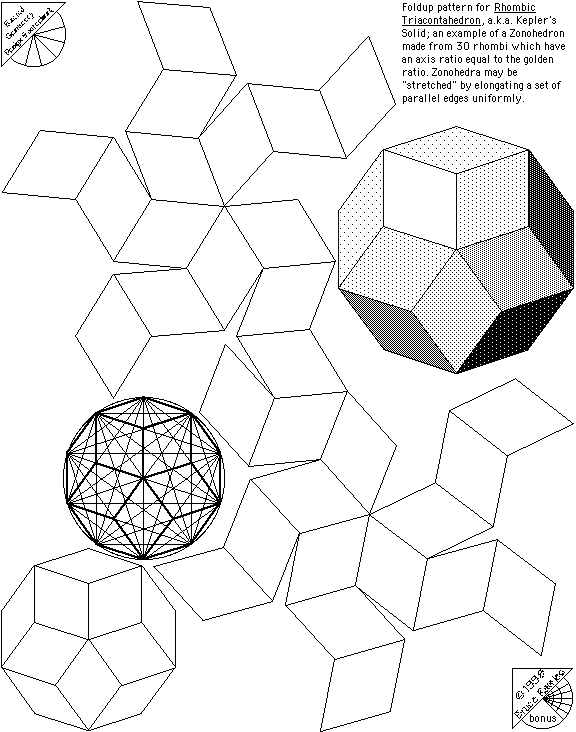
Here are the pages and posts on this website that refer to SGDS; enjoy! :-)
Last, but not least, I’m copying the content from a personal blog post (from a decade ago) which provides details on many of the images in SGDS, including how to draw many of the 2-D patterns (which took the form of an email Q and A response):
(Question)
Dear Bruce:I was reading your web pages about your book SACRED GEOMETRY DESIGN SOURCEBOOK and I wondered if you could tell me whether the book provides the reader with details of how to draw the 2-D patterns for themselves or whether they are just templates without such instruction.
(Answer)
The simplest answer is “yes and no”, depending on which of the 1300+ images you’re referring to.The detailed answer is (here goes!) that I cover some of the philosophy and underlying math, concepts and archetypal ideas in the beginning of the book, and provide a generous assortment of references in the back of the book. For the remainder (majority of the 256 pages), I give the images as much room as possible so that not only can the patterns be photocopied easily (I went with spiral binding just for that reason), the image quality would be as high as possible for an 8.5″ by 11″ format.
Some of the illustrations give step-by-step procedures (in graphical form, assuming some basic familiarity with how to use a compass and straightedge), such as:
page 44 (showing how “unit cells” for the tiling patterns can be used to create an enormously expanded variety of additional patterns by recognizing how the space-filling shapes can be varied; this applies to the “unit cell” examples on pages 16-43,
page 45 (showing how each of the patterns on pages 16-43 can embellished with fractal or other inscribed detail for each of the polygons for an infinite (literally!) variety of possible variations, (which actually also applies to the majority of the remaining images in the book; page 237 gives a 3D example of this),
pages 46-84 have either explicit (most of these pages) or simple to observe implicit “unit cells” which show how these can be created in a great variety of ways,
page 84 (Pentagon Rotation Grid) gives the 73.2% proportion crucial to the exact construction of this pattern,
page 85 (Genesis of the Seed of Life) shows the step-by-step “compass only” construction of this important and universal pattern,
page 86-95 (variations on Seed of Life and Flower of Life) show how once the Seed of Life is constructed, so many other patterns can be easily derived – Flower of Life, Hexagonal Grid, 2nd Harmonic Overlay (which is used in Mika Feinberg’s beautiful LightSOURCE screensaver animation; see my Resources page, Tree of Life, Fruit of Life, Heart and Ankh matrices, recursions, Metatron’s Cube, etc.),
page 95: since the Dodecahedron is the most complicated shape to derive from Metatron’s cube, the top center illustration on this page shows which vertices are used to create the “dodecahedron 2D shadow” with small circles highlighted in the larger image,
page 96: The general instructions for creating Nested Inscribed Polygons appear on this page,
page 100-102: other examples of the crucial proportions needed to create these image either by hand or with a computer graphics program; numerous pages provide these instructions in the text without detracting from the space given to the images,
pages 104-105, 110-113, 123-124, 128, 130, 138-139, 144-145, 155, 163, 166, 171, 176-180, 182-187: all have instructions and details on how to create the images,
page 146: very detailed step-by-step instructions for inscribing a pentagon within a circle,
page 147: very detailed step-by-step instructions for inscribing a pentagon starting from one side of a given length,
page 156: very detailed step-by-step instructions for creating a golden rectangle (including “whirling squares and more),
page 156: very detailed step-by-step instructions for dividing a line by the golden ratio,
page 157: very detailed mathematical information about golden ratio progressions and powers, illustrated graphically,
page 188: shows how the Parthenon at the Acropolis in Athens, Greece incorporates the golden ratio
page 189: an amazing amount of data on this page about the Great Pyramid at Giza, Egypt showing phi (golden ratio) and pi proportions, and the proportions of the so-called “King’s Chamber” although the so-called “sarcophagus” (granite box) within is too large to fit through the only passage leading into that chamber, which violates the generally accepted funerary rite theory,
page 190: the classic “Measure of Man” (Vitruvian Man) by Leonardo daVinci, copied around the world, showing the golden ratio proportions in the human body,
page 191: the only known CAD drawing adaptation (to my knowledge) of Leonardo’s “Ideal Church” sketch,
page 192: detailed specifics about the Shoemaker’s Knife of Archimedes, giving several variations all showing the mathematical principle,
page 194: details of the geometry of the classic 1991 Barbury Castle, England crop circle formation,
page 195 and page 52: the details of the geometry encoded in the Sri Yantra (a classic Hindu mandala) and the cross section of the Great Pyramid at Giza, Egypt (also the “squaring the circle” conundrum), both with a 1-Phi-Square Root of Phi triangle which has a 51 degree, 51 minute slope,
page 196: numerous details common to the 5 Platonic and 13 Archimedean Solids,
pages 197-214; numerous details specific to the 5 Platonic and 13 Archimedean Solids, including how the insphere/intersphere/circumsphere/side length proportions are calculated,
pages 215-224: similar details specific to the 4 Kepler-Poinsot solids, the Star Tetrahedron (a.k.a. Stella Octangula) and related polyhedra,
pages 225-229: numerous graphics showing how the Platonic Solids relate to each other in a myriad of fascinating – awe-inspiring, really! – ways,
pages 230-235: numerous relationships between 3D polyhedra with 5-sided symmetry and the “shadow” they cast on a decagon (10-sided polygon), with construction details,
page 236: step-by-step instructions on creating an accurate drawing of the Icosahedron and Dodecahedron starting from a Golden Rectangle,
pages 237-255: generous appendices for hands-on explorers of all ages and levels of experience, including tables and charts of regular polygon angles, apothem, radius and side ratios and areas, radius ratios by coordination number for Ionic Chemical Bonding (which relates to properties of materials at the molecular and planetary levels), Fibonacci Numbers, Perfect Right Triangles (when I put the book together, I wasn’t aware of the Phi-1/Phi-Square Root of 3 Right Triangle that Mike Green of British Columbia introduced me to), Prime Numbers, extensive tables with all sorts of data on the Platonic and Archimedean Solids (useful for a variety of purposes, including model construction and computer simulation and animation, a map of planet Earth showing superimposed Platonic Solid Vertex Latitudes and (example) Longitudes, a fun stereogram with 6 Small Stellated Dodecahedra (there, I gave the clue away
, a short bio of myself, 3 pages of bibliography (more on my links pages and blog), and unique graphical index to all the illustrations in the book. Whew! I’d almost forgotten how much I packed into this labor of love over a decade ago!
Many of the 1300+ images are somewhat self-explanatory graphically (especially if you have created the basic shapes like the Seed of Life, Golden Rectangle and a few others by hand with compass and straight-edge, which I highly recommend for anyone as mentor Keith Critchlow so aptly reminded me when reviewing my original manuscript)…
… and of course, if you are finding re-creating one of the patterns challenging, I’d be happy to answer other questions via email that I can share with other enthusiasts on my blog (which I’ll do with this reply; thanks for asking! :-)
I’m also working on a number of related projects that will complement the book with video “hands on” procedures, etc. Stay tuned!


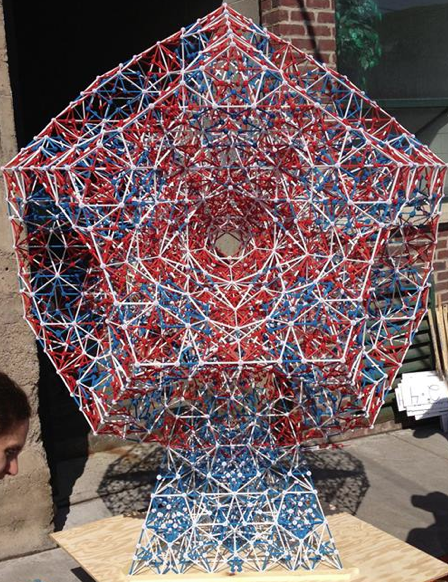
 Thanks to
Thanks to 